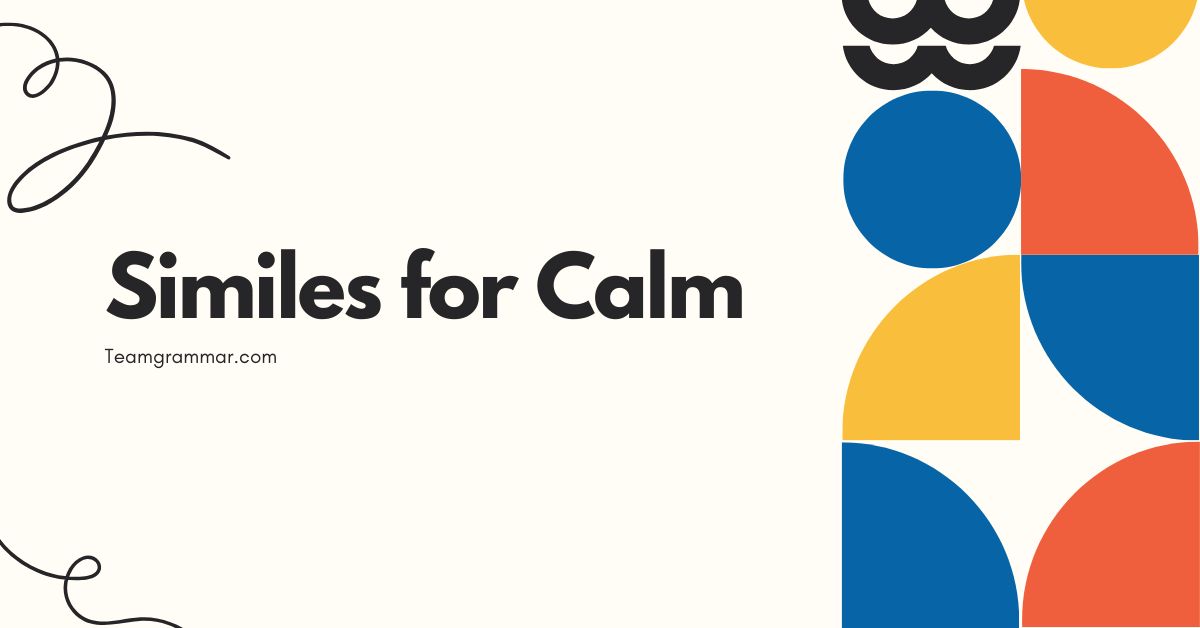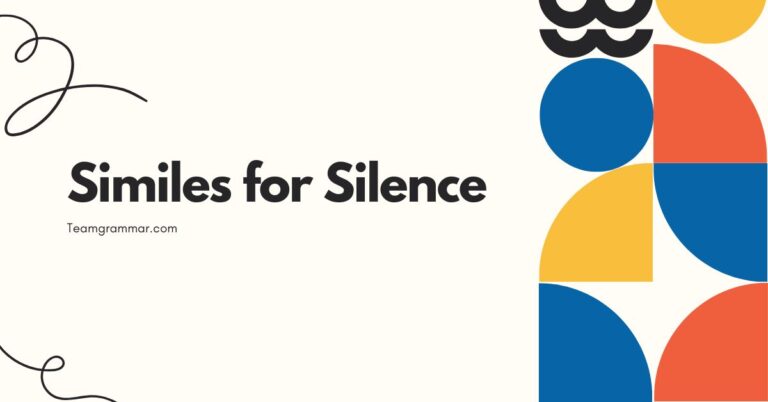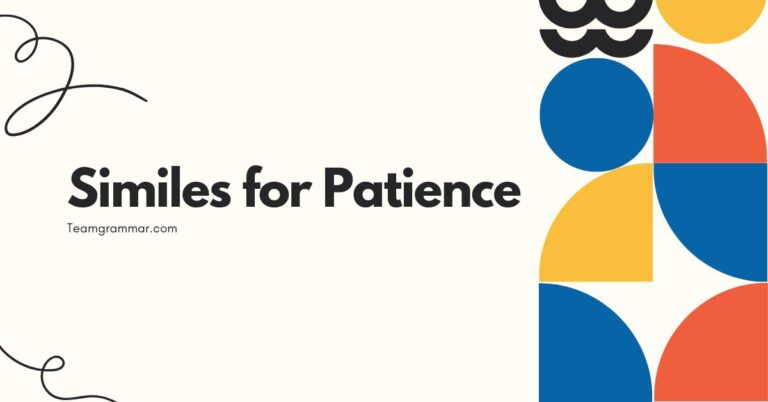31 Similes for Calm: A Comprehensive Guide to Figurative Language
Similes are powerful tools in the English language, allowing us to create vivid and relatable descriptions by comparing one thing to another using words like “like” or “as.” When it comes to expressing calmness, similes can be particularly effective. They help us paint a picture of tranquility and serenity, making our writing or speech more engaging and impactful.
This article explores the art of using similes to convey calmness, providing a detailed guide for learners of all levels. Understanding and mastering these similes will enhance your ability to express emotions and paint vivid pictures with words.
This guide is beneficial for students, writers, and anyone looking to improve their descriptive language skills.
Table of Contents
- Definition of Similes for Calm
- Structural Breakdown of Similes
- Types or Categories of Similes for Calm
- Examples of Similes for Calm
- Usage Rules for Similes
- Common Mistakes with Similes
- Practice Exercises
- Advanced Topics
- FAQ Section
- Conclusion
Definition of Similes for Calm
A simile is a figure of speech that compares two different things using the words “like” or “as.” The purpose of a simile is to create a vivid image or make a concept more understandable by drawing a parallel between the unfamiliar and the familiar. When we talk about “similes for calm,” we specifically refer to similes that evoke a sense of peace, tranquility, or serenity.
These similes help us describe a state of calmness by comparing it to something else that is inherently peaceful. The effectiveness of a simile lies in its ability to resonate with the reader or listener, creating a shared understanding of the feeling or state being described.
In essence, a simile for calm takes a feeling of calmness and equates it, using ‘like’ or ‘as,’ to something concrete and easily imaginable. For example, describing someone’s voice as being “like a gentle breeze” immediately conveys a sense of soothing and peacefulness.
The core function of such similes is to enhance descriptive writing and provide a deeper emotional connection with the audience.
Structural Breakdown of Similes
The structure of a simile is quite straightforward, typically consisting of three main components: the subject being described, the linking word (“like” or “as”), and the object of comparison. Understanding this structure allows for the creation of effective and evocative similes.
- Subject: This is the person, place, thing, or concept that you are describing as calm.
- Linking Word: This is either “like” or “as,” which connects the subject to the object of comparison.
- Object of Comparison: This is the thing that the subject is being compared to, chosen because it embodies the quality of calmness.
Here’s a breakdown with examples:
- “He was as calm as a sleeping baby.” Here, “he” is the subject, “as” is the linking word, and “a sleeping baby” is the object of comparison.
- “Her voice was like a still lake.” In this case, “her voice” is the subject, “like” is the linking word, and “a still lake” is the object of comparison.
The key to creating effective similes lies in choosing an object of comparison that strongly resonates with the desired emotion or quality. The more vivid and relatable the object of comparison, the more impactful the simile will be.
Types or Categories of Similes for Calm
While all similes for calm share the common goal of evoking a sense of peace, they can be categorized based on the specific imagery they employ. These categories help in understanding the different nuances that can be conveyed through similes.
Nature-Based Similes
These similes draw comparisons to elements of nature that are traditionally associated with calmness, such as gentle breezes, serene landscapes, and tranquil waters. Nature-based similes are widely used due to their universal appeal and accessibility.
Animal-Based Similes
These similes compare calmness to the behavior or characteristics of certain animals, often those known for their gentle nature or peaceful demeanor. Examples include comparing someone to a sleeping cat or a grazing sheep.
Object-Based Similes
These similes use inanimate objects to convey a sense of calmness. These objects are chosen for their association with stillness, simplicity, or quietude.
Examples might include a still pond, a feather floating in the air, or a gently swaying hammock.
Abstract Similes
These similes compare calmness to abstract concepts or feelings, such as silence, tranquility, or inner peace. While more subtle, these similes can be incredibly powerful in conveying a deep sense of serenity.
Examples of Similes for Calm
Here are some examples of similes for calm, organized by the categories discussed above. Each category provides a variety of similes to illustrate the breadth and depth of this figurative language.
Nature-Based Similes Examples
The following table illustrates nature-based similes used to describe various aspects of calmness. The examples are designed to show the versatility of nature imagery.
| Subject | Simile |
|---|---|
| Her voice | was like a gentle breeze on a summer evening. |
| The lake | was as still as glass. |
| His mind | was like a calm ocean after a storm. |
| The forest | was as quiet as a sleeping giant. |
| The waterfall | flowed as peacefully as a lullaby. |
| The meadow | was as serene as a painting. |
| The sunset | was like a warm embrace. |
| The morning dew | lay as gently as a whisper. |
| The mountains | stood as silently as ancient guardians. |
| The clouds | drifted like soft cotton. |
| The moonlight | shone as softly as a mother’s gaze. |
| The river | flowed as smoothly as silk. |
| The wind | was as gentle as a feather’s touch. |
| The stars | twinkled as serenely as distant lights. |
| The garden | was as peaceful as a sanctuary. |
| His smile | was like the first bloom of spring. |
| The countryside | stretched out as tranquilly as a dream. |
| The sky | was as clear as crystal. |
| The trees | stood as still as statues. |
| The air | felt as refreshing as a mountain spring. |
| Her laughter | sounded like the gentle rustling of leaves. |
| The valley | lay as peacefully as a sleeping child. |
| The dawn | broke as quietly as a secret. |
| The breeze | whispered as softly as a lullaby. |
Animal-Based Similes Examples
The following table presents similes that use animal imagery to evoke calmness. These examples highlight the gentle and peaceful qualities of various animals.
| Subject | Simile |
|---|---|
| He slept | like a sleeping kitten curled in a warm blanket. |
| She moved | as gracefully as a swan gliding on a lake. |
| His breathing | was as gentle as a dove’s coo. |
| Her presence | was as soothing as a purring cat. |
| The baby | slept as soundly as a hibernating bear. |
| He sat | as still as a perched owl. |
| She watched | as calmly as a grazing sheep. |
| His touch | was as light as a butterfly’s wing. |
| Her eyes | were as peaceful as a deer in the forest. |
| The dog | lay as quietly as a sleeping lion. |
| He waited | as patiently as a heron by the water. |
| She listened | as attentively as a mother bird. |
| His heart | beat as steadily as a tortoise’s pace. |
| She floated | as effortlessly as a jellyfish in the sea. |
| The horse | stood as calmly as a statue in the field. |
| His footsteps | were as silent as a cat’s prowl. |
| She smiled | as warmly as a dolphin’s greeting. |
| His gaze | was as gentle as a lamb’s bleat. |
| The bird | sang as sweetly as a nightingale’s song. |
| He rested | as peacefully as a sloth in a tree. |
| Her movements | were as fluid as a snake’s slither. |
| The fish | swam as serenely as a koi in a pond. |
| He observed | as keenly as an eagle’s eye. |
| She breathed | as softly as a butterfly’s flutter. |
Object-Based Similes Examples
This table provides similes using inanimate objects to depict calmness. These objects are chosen for their inherent stillness and tranquility.
| Subject | Simile |
|---|---|
| His mind | was like a still pond, reflecting the sky. |
| Her heart | was as light as a feather floating in the air. |
| The room | was as quiet as a library. |
| His thoughts | were as smooth as polished stones. |
| The atmosphere | was as peaceful as a sanctuary. |
| His demeanor | was as steady as a rock. |
| Her presence | was as comforting as a warm blanket. |
| The silence | was as deep as a well. |
| His spirit | was as free as a bird in flight. |
| Her soul | was as clear as a crystal. |
| The moment | hung as still as a painting. |
| His words | were as soothing as a balm. |
| Her touch | was as gentle as silk. |
| The feeling | was as light as air. |
| His gaze | was as unwavering as a lighthouse. |
| Her smile | was as bright as a candle in the dark. |
| The memory | lingered as softly as a perfume. |
| His presence | felt as grounding as the earth. |
| Her energy | was as calming as a cup of tea. |
| The situation | felt as stable as a sturdy table. |
| He stood | as firm as an oak tree. |
| She sat | as relaxed as a hammock swaying in the breeze. |
| His voice | was as smooth as velvet. |
| The night | was as dark as ink. |
Abstract Similes Examples
The following table showcases similes that use abstract concepts to describe calmness. These examples require a deeper understanding of the emotions and ideas being conveyed.
| Subject | Simile |
|---|---|
| His mind | was like a sanctuary of inner peace. |
| Her heart | was as full of serenity as a quiet meditation. |
| The feeling | was like a gentle wave of tranquility washing over her. |
| His presence | was as comforting as a feeling of security. |
| The moment | felt as timeless as eternity. |
| Her soul | was as pure as innocence itself. |
| His thoughts | were as clear as understanding. |
| The atmosphere | was as soothing as contentment. |
| His spirit | was as light as joy. |
| Her essence | was as calming as acceptance. |
| The silence | was as profound as wisdom. |
| His words | were as gentle as compassion. |
| Her touch | was as healing as empathy. |
| The experience | felt as liberating as freedom. |
| His demeanor | was as composed as self-assurance. |
| Her energy | was as balanced as harmony. |
| The memory | lingered as sweetly as nostalgia. |
| His gaze | was as reassuring as trust. |
| Her smile | was as genuine as love. |
| The situation | felt as manageable as control. |
Usage Rules for Similes
While similes offer creative freedom, there are certain rules and guidelines to follow to ensure their effective use. These rules focus on clarity, relevance, and originality.
- Clarity: The comparison should be clear and easily understood. Avoid obscure or overly complex comparisons that might confuse the reader.
- Relevance: The object of comparison should have a clear connection to the quality being described. The comparison should feel natural and logical.
- Originality: While common similes can be effective, strive for originality to make your writing more engaging and memorable. Avoid clichés whenever possible.
- Consistency: Ensure that the simile is consistent with the overall tone and style of your writing. A jarring or out-of-place simile can detract from the overall effect.
It’s important to consider the audience when choosing similes. What might be a familiar comparison to one person could be completely foreign to another.
Tailor your similes to resonate with your intended audience.
Common Mistakes with Similes
Even experienced writers can make mistakes when using similes. Here are some common errors to avoid:
- Using Clichés: Overused similes like “as quiet as a mouse” can make your writing sound unoriginal.
- Illogical Comparisons: Comparing things that have no logical connection can confuse the reader. For example, “He was as calm as a speeding train” makes no sense.
- Overly Complex Similes: Similes should enhance understanding, not obscure it. Avoid overly complex or convoluted comparisons.
- Mixing Metaphors and Similes: Be careful not to inadvertently create a mixed metaphor by combining a simile with a metaphorical expression.
Here’s a table illustrating correct and incorrect examples:
| Incorrect | Correct | Explanation |
|---|---|---|
| He was as calm as a busy street. | He was as calm as a quiet library. | The comparison to a busy street is illogical for describing calmness. |
| She was as calm as calm can be. | She was as calm as a sleeping baby. | The first example is redundant and lacks a concrete comparison. |
| His mind was like a whirlwind of tranquility. | His mind was like a serene lake. | A whirlwind contradicts the idea of tranquility. |
Practice Exercises
Test your understanding of similes for calm with these exercises. Fill in the blanks to complete the similes, or create your own similes based on the given subjects.
Exercise 1: Fill in the Blanks
Complete the following similes with appropriate comparisons:
- Her voice was as soothing as __________.
- His mind was like __________.
- The room was as quiet as __________.
- She moved as gracefully as __________.
- He slept as soundly as __________.
- The atmosphere was as peaceful as __________.
- His presence was as comforting as __________.
- The silence was as deep as __________.
- Her soul was as clear as __________.
- The feeling was like __________.
Answer Key:
- a gentle stream
- a calm sea
- a tomb
- a swan
- a log
- a temple
- a warm fire
- space
- crystal
- a soft blanket
Exercise 2: Create Your Own Similes
Create similes for the following subjects, using “like” or “as”:
- The sunset
- A gentle breeze
- A sleeping cat
- A quiet forest
- A peaceful garden
- A calm lake
- A serene mountain
- A tranquil river
- A still pond
- A quiet meadow
Sample Answers:
- The sunset was like a painter’s masterpiece, blending hues of orange and pink.
- A gentle breeze is as soft as a whisper, caressing the skin.
- A sleeping cat is like a furry ball of contentment, purring softly.
- A quiet forest is as still as a sanctuary, filled with ancient wisdom.
- A peaceful garden is like a haven of tranquility, blooming with vibrant colors.
- A calm lake is as smooth as glass, reflecting the sky above.
- A serene mountain stands as silently as a guardian, watching over the land.
- A tranquil river flows like a ribbon of peace, winding through the landscape.
- A still pond is as reflective as a mirror, capturing the beauty of its surroundings.
- A quiet meadow is like a sea of green, swaying gently in the breeze.
Advanced Topics
For advanced learners, exploring the nuances of similes can lead to more sophisticated and impactful writing. Here are some advanced topics to consider:
- Subverted Similes: These similes intentionally defy expectations, creating a surprising or ironic effect.
- Extended Similes: These similes are developed over several sentences or paragraphs, creating a more elaborate comparison.
- Similes in Poetry: Exploring how similes are used in poetry to create imagery, rhythm, and emotional depth.
- Cultural Context: Understanding how cultural background can influence the interpretation and effectiveness of similes.
Experimenting with these advanced techniques can elevate your writing and allow you to express yourself with greater precision and creativity. Consider how different similes might resonate with different audiences based on their backgrounds and experiences.
FAQ Section
Here are some frequently asked questions about similes:
- What is the difference between a simile and a metaphor?
A simile compares two things using “like” or “as,” while a metaphor directly equates two things without using these words. For example, “He is like a lion” (simile) vs. “He is a lion” (metaphor).
- Can a simile be a cliché?
Yes, overused similes become clichés. It’s best to avoid them and strive for more original comparisons.
- How can I make my similes more effective?
Choose relevant, vivid, and original comparisons. Consider your audience and the overall tone of your writing.
- Is it okay to use multiple similes in one paragraph?
Yes, but use them sparingly. Too many similes can become overwhelming and detract from the clarity of your writing.
- What are some common examples of similes?
Common examples include “as brave as a lion,” “as quiet as a mouse,” and “like a fish out of water.”
- How do I avoid using clichés in my similes?
Think outside the box and brainstorm unique comparisons. Consider specific details and sensory experiences to make your similes more vivid.
- Can similes be used in any type of writing?
Yes, similes can be used in various types of writing, including fiction, poetry, essays, and even technical writing, to enhance clarity and engagement.
- What role does imagery play in similes?
Imagery is crucial in similes. Effective similes create vivid mental images that help the reader understand and connect with the comparison.
- How do I choose the right object of comparison for my simile?
Choose an object that shares a key characteristic with the subject you’re describing. Consider what qualities you want to emphasize and select an object that embodies those qualities.
- Are similes important for descriptive writing?
Yes, similes are essential for descriptive writing because they allow you to create vivid and engaging descriptions by comparing unfamiliar things to familiar ones.
- What is a subverted simile and how is it used?
A subverted simile is one that intentionally defies expectations, often for humorous or ironic effect. For example, “He was as brave as a kitten facing a vacuum cleaner.”
- How can understanding cultural context improve the effectiveness of my similes?
Cultural context influences how people interpret and relate to different comparisons. Being aware of cultural nuances can help you choose similes that resonate with your target audience and avoid comparisons that might be misunderstood or offensive.
Conclusion
Mastering the art of using similes, especially those that evoke calmness, can significantly enhance your writing and communication skills. By understanding the structure, types, and usage rules of similes, you can create vivid and engaging descriptions that resonate with your audience.
Remember to avoid clichés and strive for originality to make your writing more memorable. Practice regularly and experiment with different comparisons to develop your own unique style.
With careful attention and practice, you can effectively use similes to paint pictures of tranquility and serenity with your words.
The key takeaway is that similes are powerful tools for descriptive writing, and understanding their nuances allows for more effective communication. By focusing on clarity, relevance, and originality, you can create similes that not only enhance your writing but also deepen the emotional connection with your audience.
Keep practicing and experimenting to refine your skills and unlock the full potential of this versatile figure of speech.







